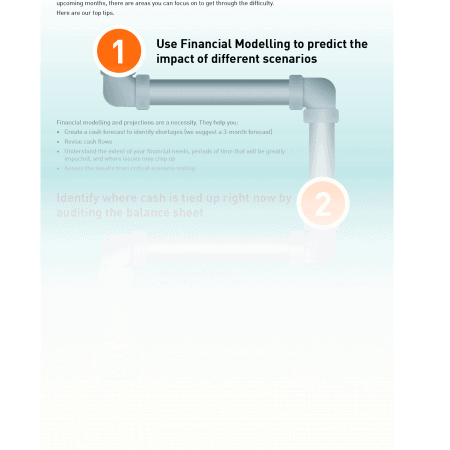The COVID-19 pandemic is a public health crisis, but with it came increased economic pressure, especially for small or medium businesses. They stand at a particularly vulnerable point if they have low cash reserves or unstable cash flows.
Now is the time to take advantage of strategic tools to help you maintain continuity. For example, financial modelling tools and stress testing can show you the issues you may run into, based on different scenarios. Some use the valuable data you already have. Others use AI or advanced statistical models to show you all the avenues you can take.
Quick Tips
- In the current business conditions, it may be pertinent to shift your focus from the income statement to the balance sheet. Now is the time to look at the practical back-office steps (like paying bills and collecting receivables) that can keep you afloat.
- Understand your business interruption insurance. You should know and understand the business insurance policy and what coverage you may or may not have in the event of a significant disruption to business.
Financial Options to maintain cash flow
Export Development Canada (EDC) and the Business Development Bank of Canada (BDC) have created the Business Credit Availability Program (BCAP). This program will provide $10bn of additional funding for businesses that have been impacted by the coronavirus pandemic. It is available to Canadian business “in all sectors and regions”. The funding is provided by EDC, BDC and private sector lenders.
Here is what the program covers:
- Working capital loans of up to $2 million with flexible terms and payment postponements for up to six months for qualifying businesses.
- Postponement of payments for up to six months, free of charge, for existing BDC clients with total BDC loan commitment of $1 million or less
- Reduced rates on new eligible loans
- Additional BCAP measures, including industry specific support, to come
- The Canadian government is focused on providing tax and non-tax relief measures to:
- Fund businesses for liquidity and stabilization
- When it comes to generating/conserving cash, there are tax opportunities to consider, including assessing previous refunds, prior and future tax instalments, direct and indirect taxes, debt
Audit your AR
It may sound obvious, but being strategic about how you operate your Accounts Receivable operations can help you meet the cash flow demands that you face. There are a few main actions you can take to help you free up some cash.
-
Invoice in a timely manner.
- Identify any bottlenecks that hold up your invoicing. You may state that you are Net 30, but in practicality, you might be closer to Net 45 because of the delay in getting an invoice issued.
- Evaluate whether you should capture delivery details on a more regular basis?
- Think about ways to streamline this process so that you can get invoices out and money in quicker.
-
Focus on your collections
- If your invoices are issued as soon as possible, it might be worth shifting focus to your collections.
- Some customers may not have the money right now. Are there others that are not paying, not because they do not have the money, but because they dispute a charge? Work with those debtors to solve the problem and get that payment in.
- Implement a collections campaign to reduce number of receivables.
-
Take advantage of contract terms
- If you normally issue payments as soon as they come in, it might be time to take advantage of the payment terms.
- If you are paying on time, is there a potential discount that you’re not taking advantage of?
- Don’t be afraid to renegotiate terms. For example, you might make use of 2% 10 Net 30 terms. These are a common payment term that offers a 2% discount if you pay a Net 30 invoice within 10 days.
-
Break up large payments
- If large projects require a large amount of resources or materials, try breaking the payment into phases. For example, pay ? deposit, ? at a specific milestone and ? on completion.
-
Increase ways to pay
- Make it easy for debtors to pay you. Quicker, easier payment can be facilitated through EFT or credit card payments.
-
Use factoring
- Extend or set up Factoring and Reverse Factoring Reverse factoring programs can be implemented in a couple weeks using digital platforms.

